617 Search Results for tell me about it
July 16, 2020
by Carole Zangari -
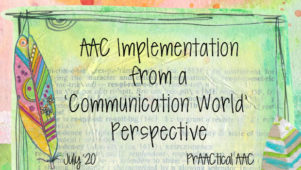
AAC SLPs are a creative bunch and would do anything to help teams get on board with appropriate supports and services. In today’s post, we hear from Elena Feder, who introduces us to the ‘Communication World’ approach. Elena is an AAC SLP at the New England Assistive Technology (NEAT) Center in Connecticut and has a lot to share about AAC implementation. Don’t miss the wonderful planning tool that she shares at the end. Before we get to that, though, take a look at the AAC Summer Bash that she runs with her colleague and fellow SLP Sarah Brink. In normal times, this is a face-to-face experience but due to the novel coronavirus, it has migrated to an online event. There are a few other things that you might like to know about the AAC Summer Bash. It’s free! You’re invited! You must register by July 17th. The AAC Summer Bash... [Read More...]
June 25, 2020
by Carole Zangari -
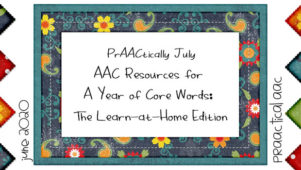
It’s almost July and that gives us an opportunity to turn our attention to an additional set of core vocabulary. Do you know anyone who has access to AAC tools but doesn’t yet use them throughout the day? Keiran has a new AAC app that is well-populated with core vocabulary. Gabbie has had an SGD for a while but doesn’t use it as frequently as her team had hoped. Hudson is transitioning from PECS to an AAC device with more robust language. While different in many ways, each of these learners has a common need: frequent opportunities to learn about and use core vocabulary. To accomplish this, their SLPs, teachers, and families select a dozen or so core words and pay special attention to those each month. That allows them to highlight this small group of words using focused language stimulation, aided language input, and specific activities designed to teach... [Read More...]
May 21, 2020
by Carole Zangari -
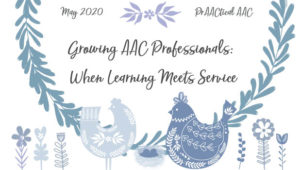
Teaching AAC to future SLPs is a longstanding passion of mine so when a fellow instructor, Vicki Haddix, reached out to talk about the AAC projects her graduate students had done, I knew that I wanted to share them with you. In today’s post, Vicki, a Clinical Assistant Professor at the University of Memphis, tells us about her most recent students and their projects. The materials they created can be used by parents and professionals alike. Make sure to check out the link at the bottom to access the full array of materials that these talented students created. Enjoy! ::::::::::::::::::::::::::::::::::::::::::::::::::::::::::::::::::::::::::::::::::::::::::::::::::::::::::: As a professor, it’s always exciting when you see the great work that graduate students are doing and think about the potential that they are bringing to the field. I’ve taught the AAC class at the University of Memphis’s SLP graduate program for 5 spring semesters, and I always learn... [Read More...]
April 23, 2020
by Carole Zangari -
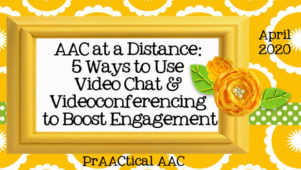
Like many of you, I have a love-hate relationship with video chat and videoconferencing these days. On one hand, we are immensely grateful for the technology that allows us to teach classes and hold meetings remotely so that we can continue with some semblance of our daily obligations. On the other hand, there is just no substitute for being in the same physical space as our co-workers, students, friends, and relatives. We are all adapting to this new reality of social distancing and experimenting with new ways of teaching, learning, and working. Across the globe, people are using video chat and videoconference technology, like FaceTime, Google Hangouts, and Zoom, in creative ways. If you’re looking for some ways to support AAC learners using these technologies, here are a few ideas. Hold a virtual Friendship Friday meeting: Invite a few classmates or friends to join an online meeting space to do... [Read More...]
March 30, 2020
by Carole Zangari -
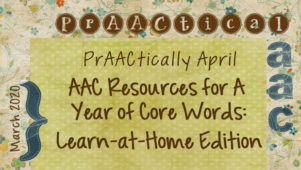
We’re entering a new era in AAC learning, one that’s centered around learning at home. Whether you are a parent trying to keep your child’s AAC skills up in the absence of their regular therapy and schooling, or a professional who is providing AAC support from afar, we hope that our monthly Year of Core Vocabulary Learn-at-Home Edition posts help you stay focused and keep your learners using their AAC skills. In today’s post, we share some ideas for boosting core word learning throughout the week with a focus on a small set of words. Whether you are following along with the Set 1 (12 words/month) or the Set 2 words (16 words/month; Different than the previous core words), or are just getting started, this post has some helpful resources. Our words for this month are as follows. Set 1 List: big, busy, do, drink, feel, he, in, make, out, some, tell, who... [Read More...]
February 17, 2020
by Carole Zangari -
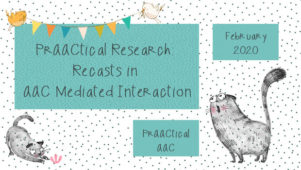
Today, we welcome back guest author Dr. Kathy Howery for another wonderful discussion of an important AAC research article. Dr. Howery’s work in AT and special education spans three decades and her research uses phenomenological methods to increase our understanding of the lived experience of people who use AAC. She works with the Ministry of Education low incidence team, and as a consultant to schools and school districts across Alberta focusing primarily on children and youth with complex communication needs. In this post, Dr. Howery reviews an important article describing research on recasting in AAC mediated conversations. Recasts in AAC Mediated Interaction Soto, G., Clarke, M. T., Nelson, K., Starowicz, R., & Savaldi-Harussi, G. (2020). Recast type, repair, and acquisition in AAC mediated interaction. Journal of Child Language, 47, 250-264. https://doi.org/10.1017/S03035000919000436 What this article is about (the focus of the research)? This article focuses its attention on the power of... [Read More...]
November 21, 2019
by Carole Zangari -
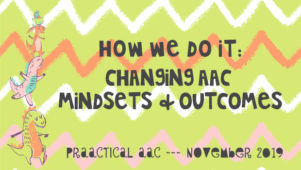
As AAC interventionists, we spend a lot of time helping therapists, teachers, families, and others develop their appreciation for multimodal communication and build their skills in using supportive strategies. In today’s post, Deidre Dobbels, a speech-language pathologist specializing in AAC, language and literacy development in young children, shares her thoughts on how we can do this effectively. Deidre is employed by Barrington CUSD #220 in the Northwest Suburbs of Chicago in which a Universal Core Approach to Language and Literacy has been in place for nearly a decade. Deidre authored a multi-media early developing core vocabulary curriculum used by her school district as well as by therapists and teachers throughout the Midwest. In her guest post, Deidre talks about her experiences in addressing the AAC needs of young children with complex communication needs. Changing Mindsets, Changing Outcomes As a young Speech Language Pathologist working in Early Childhood classrooms, I was... [Read More...]
May 2, 2019
by Carole Zangari -

If it’s May, it must be Better Hearing and Speech Month (#BSHM), and we’re thrilled to kick off the festivities by two Illinois-based SLPs, Dr. Jill Senner and Matt Baud. They have a wealth of AAC experience and have generously shared their expertise here in several previous posts. Today, we welcome them back as they share some advice on helping staff use AAC in natural settings. Enjoy! ::::::::::::::::::::::::::::::::::::::::::::::::::::::::::::::::::::::::::::::::::::::::::::::::::: Put Me in, Coach: Coaching AAC Use in the Natural Environment “Help, I already trained the team and the device is still not being used outside of my sessions.” Sound familiar? We hear this a lot. This actually is quite common if one key training element is missing. In fact, without this critical instructional component, there’s only about a 5% chance that the strategies you’re teaching will actually be used in the natural environment. What is the essential ingredient to maximizing your... [Read More...]
March 18, 2019
by Carole Zangari -
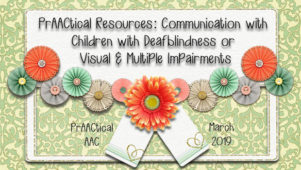
Many of us work with learners who have significant visual difficulties along with another disability such as hearing loss, autism, or intellectual disabilities. Today, we look at the Communication Resources from the Texas School for the Blind and Visually Impaired which is geared to helping teachers, therapists, and parents get familiar with some basic communication principles and instructional strategies. It includes sections on topics such as interaction/bonding, building security, play, calendars, and a video series by Sara Kitchener. Enjoy!
February 11, 2019
by Carole Zangari -
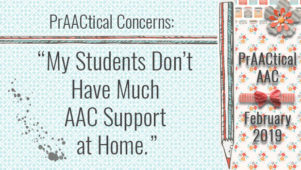
At a conference last month, I had some wonderful interactions with teachers and SLPs who are incredibly dedicated to helping their students with AAC needs become more proficient communicators. A number of common threads emerged through comments like these. “It’s really frustrating! My student would make SO much more progress if there was carryover at home.” “I keep telling my student’s parents this but they don’t really follow through.” “I’ve told them about the research and shared a lot of web links with them, but nothing seems to change. My student’s family still doesn’t really use his AAC at home.” “The family tells me that they are modeling AAC, but when I look at the ‘history’ it shows that not much AAC is happening outside of school hours.” In person and through social media, professionals have shared their stories and expressed that they are sometimes surprised and puzzled but mostly disappointed... [Read More...]









